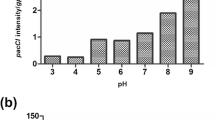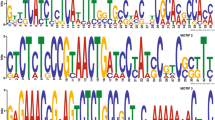Abstract
The phosphate analogue phosphite is widely used to control diseases of plants caused by oomycete pathogens such as those within the genus Phytophthora. Phosphite inhibits zoospore production and growth of P. cinnamomi. However, very little is known about the underlying mechanism of action. In the present study, we grew P. cinnamomi in Ribero’s liquid medium with 0.1 mM phosphate, with and without 5 μg phosphite/mL, and used differential display reverse transcriptase-PCR (DDRT-PCR) to identify P. cinnamomi genes that are transcriptionally repressed or induced by phosphite. By using this technique, four differentially expressed bands were identified. However, quantitative measurement of the amount of mRNA transcript by RT-PCR revealed that only one gene was actually phosphite inducible. On the basis of the homology of the deduced amino acid sequence, this gene encodes a proteophosphoglycan. The remaining three bands did not show differential expression.
Similar content being viewed by others
References
Aberton MJ, Wilson BA, Cahill DM (1999) The use of potassium phosphonate to control Phytophthora cinnamomi in native vegetation at Anglesea, Victoria. Australasian Plant Pathology 28, 225–234. doi: 10.1071/AP99037
Altschul SF, Madden T, Schäffer A, Zhang J, Zhang Z, Miller W, Lipman D ((1997) Gapped BLAST and PSI-BLAST: a new generation of protein database search programs. Nucleic Acids Research 25, 3389–3402. doi: 10.1093/nar/25.17.3389
Barchietto T, Saindrenan P, Bompeix G (1988) Characterization of phosphonate uptake in two Phytophthora spp. and its inhibition by phosphate. Archives of Microbiology 151, 54–58. doi: 10.1007/ BF00444669
Barrett SR, Shearer BL, Hardy GES (2004) Phytotoxicity in relation to in planta concentration of the fungicide phosphite in nine Western Australian native species. Australasian Plant Pathology 33, 521–528. doi: 10.1071/ AP04055
Daniel R, Guest D (2006) Defence responses induced by potassium phosphonate in Phytophthora palmivora-challenged Arabidopsis thaliana. Physiological and Molecular Plant Pathology 67, 194–201. doi: 10.1016/j.pmpp.2006.01.003
Gaulin E, Jauneau A, Villal F, Rickauer M, Esquerre-Tugaaye M, Bottin A ((2002) The CBEL glycoprotein of Phytophthora parasitica var. nicotianae is involved in cell wall deposition and adhesion to cellulosic substrates. Journal of Cell Science 115, 4565–4575. doi: 10.1242/ jcs.00138
Gopfert U, Goehring N, Klein C, Ilg T (1999) Proteophosphoglycans of Leishmania mexicana. Biochemical Journal 344, 787–795. doi: 10.1042/0264-6021:3440787
Griffith JM, Smillie RH, Grant BR (1990) Alterations in nucleotide and pyrophosphate levels in Phytophthora palmivora following exposure to the antifungal agent potassium phosphonate (phosphite). Journal of General Microbiology 136, 1258–1291.
Griffith JM, Coffey MD, Grant BR (1993) Phosphonate inhibition as a function of phosphate concentration in isolates of Phytophthorapalmivora. Journal of General Microbiology 139, 2109–2116.
Hardham AR ((2005) Phytophthora cinnamomi. Molecular Plant Pathology 6, 589–604. doi: 10.1111/j.1364-3703.2005.00308.x
Hardy GEStJ, Barrett S, Shearer BL (2001) The future of phosphite as a fungicide to control the soilborne plant pathogen Phytophthora cinnamomi in natural ecosystems. Australasian Plant Pathology 30, 133–139. doi: 10.1071/AP01012
Jackson TJ, Burgess T, Colquhoun I, Hardy GEStJ (2000) Action of the fungicide phosphite on Eucalyptus marginata inoculated with Phytophthora cinnamomi. Plant Pathology 49, 147–154. doi: 10.1046/ j.1365-3059.2000.00422.x
Jorgensen M, Bevort M, Pallisgard N, Hummel R, Hansen R, Rohde M, Strauss M, Leffers H (1997) Differential display of expressed mRNAs. In ‘Fingerprinting methods based on arbitrarily primed PCR’. (Eds MR Micheli, R Bova) pp. 269–281. Springer-Verlag: Heidelberg, Germany)
Khatib M, Lafitte C, Esquerre-Tugaye MT, Bottin A, Rickauer M ((2004) The CBEL elicitor of Phytophthora parasitica var. nicotianae activates defence in Arabidopsis thaliana via three different signalling pathways. New Phytologist 162, 501–510. doi: 10.1111/j.1469-8137.2004.01043.x
Klein C, Gopfert U, Goehring N, Stierhof Y, Ilg T (1999) Proteophosphoglycans of Leishmania mexicana. Biochemical Journal 344, 775–786. doi: 10.1042/0264-6021:3440775
Liang P, Bauer D, Averboukh L, Warthoe P, Rohrwild M, Muller H, Strauss M, Pardee AB (1995) Analysis of altered gene expression by differential display. Methods in Enzymology 254, 304–321. doi: 10.1016/0076-6879(95)54022-9
Livak KJ, Schmittgen TD (2001) Analysis of relative gene expression data using real-time quantitative PCR and the 2(T) (-Delta Delta C) method. Methods (San Diego, Calif.) 25, 402–408.
Logemann J, Schell J, Willmitzer L (1987) Improved method for isolation of RNAfrom plant tissue. Analytical Biochemistry 163, 16–20. doi: 10.1016/0003-2697(87)90086-8
Malusa E, Tosi L (2005) Phosphorous acid residues in apples after foliar fertilization: results of field trials. Food Additives and Contaminants 22, 541–548. doi: 10.1080/02652030500135284
Martin H, Grant BR, Stehmann C (1998) Inhibition of inorganic pyrophosphatase by phosphonate—a site of action in Phytophthora spp. Pesticide Biochemistry and Physiology 61, 65–77. doi: 10.1006/pest.1998.2353
Mateos FV, Rickauer M, Esquerre-Tugaye M (1997) Cloning and characterization of a cDNA encoding an elicitor of Phytophthora parasitica var. nicotianae that shows cellulose-binding and lectin-like activities. Molecular Plant—Microbe Interactions 10, 1045–1053. doi: 10.1094/MPMI.1997.10.9.1045
McDonald AE, Grant BR, Plaxton WC (2001a Phosphite (phosphorous acid): its relevance in the environment and agriculture and influence on plant phosphate starvation response. Journal of Plant Nutrition 24, 1505–1519. doi: 10.1081/PLN-100106017
McDonald AE, Niere JO, Plaxton WC (2001b) Phosphite disrupts the acclimation of Saccharomyces cerevisiae to phosphate starvation. Canadian Journal of Microbiology 47, 969–978. doi: 10.1139/cjm-47-11-969
Molina A, Hunt MD, Ryals JA (1998) Impaired fungicide activity in plants blocked in disease resistance signal transduction. The Plant Cell 10, 1903–1914. doi: 10.2307/3870912
Nicot N, Hausman JF, Hoffmann L, Evers D (2005) Housekeeping gene selection for real-time RT-PCR normalization in potato during biotic and abiotic stress. Journal of Experimental Botany 56, 2907–2914. doi: 10.1093/jxb/eri285
Niere JO, DeAngelis G, Grant BR (1994) The effect of phosphonate on the acid-soluble phosphorus components in the genus Phytophthora. Microbiology 140, 1661–1670.
Niere JO, deAngelis GA, Grant JH, McDonnell J, Stringer F, Grant BR (2001) 31PNMR in vivo spectroscopy of Phytophthora palmivora mycelia. In ‘Phytophthora in forests and natural ecosystems’. Albany, Western Australia. (Eds J McComb, GS Hardy, I Tommerup) pp. 182–187. (Centre for Phytophthora Science and Management, Murdoch University: Perth)
Perez V, Mamdouh A, Huet J, Pernollet J, Bompeix G (1995) Enhanced secretion of elicitins by Phytophthora fungi exposed to phosphonate. Cryptogamie. Mycologie 16, 191–194.
Pilbeam RA, Colquhoun IJ, Shearer B, Hardy GES (2000) Phosphite concentration: its effect on phytotoxicity symptoms and colonisation by Phytophthora cinnamomi in three understorey species of Eucalyptus marginata forest. Australasian Plant Pathology 29, 86–95. doi: 10.1071/AP00016
Ponchel F, Toomes C, Bransfield K, Leong FT, Douglas SH, et al. (2003 Real-timePCR based on SYBR-Green I fluorescence: an alternative to the TaqMan assay for a relative quantification of gene rearrangements, gene amplifications and micro gene deletions. BMC Biotechnology 3, 18. doi: 10.1186/1472-6750-3-18
Rajeevan MS, Ranamukhaarachchi DG, Vernon SD, Unger ER (2001) Use of real-time quantitative PCR to validate the results of cDNA array and differential display PCR technologies. Methods (San Diego, Calif.) 25, 443–451.
Ribeiro OK (1978) ‘A source book of the genus Phytophthora.’ (J. Cramer: Vaduz, Liechtenstein)
Robold AV, Hardham AR (2005) During attachment Phytophthora spores secrete proteins containing thrombospondin type 1 repeats. Current Genetics 47, 307–315. doi: 10.1007/s00294-004-0559-8
Sambrook J, Fritsch EF, Maniatis T (1989) ‘Molecular cloning: a laboratory manual.’ 2nd edn. (Cold Spring Harbor Laboratory: Cold, Spring Harbor, NY)
Shearer BL, Crane CE, Fairman RG (2004) Phosphite reduces disease extension of a Phytophthora cinnamomi front in Banksia woodland, even after fire. Australasian Plant Pathology 33, 249–254. doi: 10.1071/AP04002
Shearer BL, Crane CE, Barrett S, Cochranev A (2007) Phytophthora cinnamomi invasion, a major threatening process to conservation of flora diversity in the South-West Botanical Province of Western Australia. Australian Journal of Botany 55, 225–238. doi: 10.1071/BT06019
Smillie R, Grant B, Guest D (1989) The mode of action of phosphite: evidence for both direct and indirect modes of action on three Phytophthora spp. in plants. Phytopathology 79, 921–926. doi: 10.1094/Phyto-79-921
Smith BJ, Shearer BL, Sivasithamparam K (1997a) Compartmentalization of Phytophthora cinnamomi in stems of highly susceptible Banksia brownii treated with phosphonate. Mycological Research 101, 1101–1107. doi: 10.1017/S0953756297003754
Smith NR, Li A, Aldersley M, High AS, Markham AF, Robinson PA (1997b) Rapid determination of the complexity of cDNA bands extracted from DDRT-PCR polyacrylamide gels. Nucleic Acids Research 25, 3552–3554. doi: 10.1093/nar/25.17.3552
Stanley MS, Perry RM, Callow JA (2005) Analysis of express sequence tags from the green algae Ulva linza (Chlorophyta). Journal of Phycology 41, 1219–1226. doi: 10.1111/j.1529-8817.2005.00138.x
Thatcher LF, Anderson JP, Singh KB (2005) Plant defence responses: what have we learnt from Arabidopsis? Functional Plant Biology 32, 1–19. doi: 10.1071/FP04135
Tyler BM (2001) Genetics and genomics of the oomycete host interface. Trends in Genetics 17, 611–614. doi: 10.1016/S0168-9525(01)02517-3
Tyler BM, Tripathy S, Zhang XG, Dehal P, Jiang RHY, et al. (2006) Phytophthora genome sequences uncover evolutionary origins and mechanisms of disease. Science 313, 1261–1266. doi: 10.1126/science. 1128796
van der Merwe M, Kotze J (1994) Fungicidal action of phosphite in avocado root tips on Phytophthora cinnamomi. South African Avocado Growers Yearbook 17, 38–45.
Wilkinson CJ, Holmes JM, Dell B, Tynan KM, McComb JA, Shearer BL, Colquhoun IJ, Hardy GES (2001a) Effect of phosphite on in planta zoospore production of Phytophthora cinnamomi. Plant Pathology 50, 587–593. doi: 10.1046/j.1365-3059.2001.00605.x
Wilkinson CJ, Shearer BL, Jackson TJ, Hardy GES (2001b) Variation in sensitivity of Western Australian isolates of Phytophthora cinnamomi to phosphite in vitro. Plant Pathology 50, 83–89. doi: 10.1046/j.1365-3059.2001.00539.x
Wong M (2006) Phosphite induces morphological and molecular changes in Phytophthora species. MPhil Thesis, Murdoch University, Perth.
Author information
Authors and Affiliations
Corresponding author
Rights and permissions
About this article
Cite this article
Wong, MH., McComb, J., Hardy, G.E.S.J. et al. Phosphite induces expression of a putative proteophosphoglycan gene in Phytophthora cinnamomi . Australasian Plant Pathology 38, 235–241 (2009). https://doi.org/10.1071/AP08101
Received:
Accepted:
Issue Date:
DOI: https://doi.org/10.1071/AP08101




